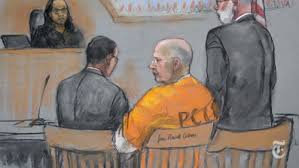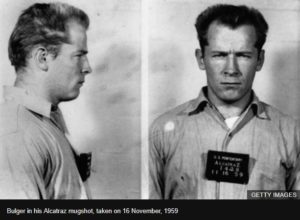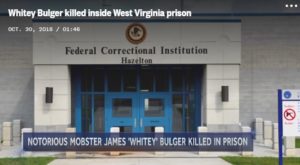 One of the world’s most infamous criminals is dead. 89-year-old James Joseph Bulger, aka Whitey—once head of the Boston Mob—was murdered inside Hazelton Federal Penitentiary in West Virginia on October 30, 2018. Authorities transferred Bulger from a Florida maximum security jail to the WV medium security facility less than 12 hours earlier. The wheelchair-bound, high-risk geriatric inmate got placed in general population. Credible prison sources say other prisoners quickly isolated and beat Bulger beyond recognition using the “lock-in-a-sock” technique, tearing his eyes from their sockets and cutting out his tongue. It was a signature end for the notorious American gangster.
One of the world’s most infamous criminals is dead. 89-year-old James Joseph Bulger, aka Whitey—once head of the Boston Mob—was murdered inside Hazelton Federal Penitentiary in West Virginia on October 30, 2018. Authorities transferred Bulger from a Florida maximum security jail to the WV medium security facility less than 12 hours earlier. The wheelchair-bound, high-risk geriatric inmate got placed in general population. Credible prison sources say other prisoners quickly isolated and beat Bulger beyond recognition using the “lock-in-a-sock” technique, tearing his eyes from their sockets and cutting out his tongue. It was a signature end for the notorious American gangster.
 Whitey Bulger was more than a larger-than-life mobster—he was a devious, double-crossing sonofabitch convicted of eleven brutally cruel murders inflicted on organized criminal associates during the 70s and 80s when South Boston’s Irish Mob ruled town. Bulger also acted as a top FBI informant and turned into a Bureau embarrassment while he continued his criminal enterprise under federal government immunity. Just before indictment on racketeering charges, Bulger’s FBI handler tipped him off. That corrupt information about pending arrest gave Bulger years on the lam before he was taken down in 2011.
Whitey Bulger was more than a larger-than-life mobster—he was a devious, double-crossing sonofabitch convicted of eleven brutally cruel murders inflicted on organized criminal associates during the 70s and 80s when South Boston’s Irish Mob ruled town. Bulger also acted as a top FBI informant and turned into a Bureau embarrassment while he continued his criminal enterprise under federal government immunity. Just before indictment on racketeering charges, Bulger’s FBI handler tipped him off. That corrupt information about pending arrest gave Bulger years on the lam before he was taken down in 2011.
My opinion is Whitey Bulger deserved what he got, and kudos to whoever whacked him. It was long overdue. Bulger should have been executed years earlier had the State of Massachusetts retained the death penalty and nabbed him. However, his murder inside the joint raises the question of what protection a high-profile and vulnerable prison inmate like Whitey Bulger is entitled to.
 That Bulger died less than a day after arrival at Hazelton suggests powers within the U.S. Bureau of Prisons intentionally placed Bulger in peril. It’s likely no coincidence convicted Boston mafia hitman, Fotios “Freddy” Geas, was on the scene and in the cell when Bulger died. Currently, Freddy sits on ice. He’s in the hole pending an investigation.
That Bulger died less than a day after arrival at Hazelton suggests powers within the U.S. Bureau of Prisons intentionally placed Bulger in peril. It’s likely no coincidence convicted Boston mafia hitman, Fotios “Freddy” Geas, was on the scene and in the cell when Bulger died. Currently, Freddy sits on ice. He’s in the hole pending an investigation.
Before examining who in the system is accountable for setting up an old con-man’s death, let’s look at Bulger’s past and what he did as a sociopathic killer.
James Bulger was born in 1929 at Everett in North Boston. His father was injured in an accident and unable to work, placing the family in poverty. From an early age, James Bulger bounced between relatives’ homes and whoever would put up with his delinquent behavior. Nicknamed “Whitey” for his platinum hair, Bulger preferred being called “Jimmy”. However, the name Whitey stuck and it stayed with him throughout his criminal career.
Whitey Bulger developed a nasty reputation as a cruel dude. At fourteen, he was a seasoned street fighter and enforcer for the South Boston Shamrock gang. Also at fourteen, Bulger went to jail for theft and burglary. He was placed in adult population and learned from some of the country’s most experienced cons.
 Bulger was in and out of prison during the war years. He tried reforming in 1948 by joining the U. S. Air Force, but that didn’t work. Whitey Bulger was jailed in military prison for assaults and being absent without leave. To get rid of Bulger, the Air Force released him with an honorable discharge in 1952. He went back to the streets of South Boston.
Bulger was in and out of prison during the war years. He tried reforming in 1948 by joining the U. S. Air Force, but that didn’t work. Whitey Bulger was jailed in military prison for assaults and being absent without leave. To get rid of Bulger, the Air Force released him with an honorable discharge in 1952. He went back to the streets of South Boston.
Whitey Bulger graduated to extortions, drug trafficking and armed robberies. By 1956, he was incarcerated for robbery in Atlanta but was transferred to Alcatraz prison at San Francisco. Bulger was too much for Alcatraz authorities to handle so they sent him to the super-maximum pen at Leavenworth. He made parole in 1965 and never saw another day in jail for 46 years.
Back in Boston, Whitey Bulger joined the Killeen gang who were established pimps and bookies as well as experienced loan sharks and bone bashers. During a gang war between the Killeens and their rival Mullen gang, Bulger committed his first known murder by shooting an unarmed man between the eyes, then biting off the end of his nose. Things heated up for the Killeens and Bulger, so he turn-coated to the powerful South Boston mob. Bulger joined the Winter Hill gang and went about setting up the Killeens to eliminate their leaders.
Whitey Bulger rapidly rose in South Boston’s underworld. He had a peculiar modus operandi, or MO, for a con. Bulger preyed only on other criminals, not the general public. It was a pattern that worked well for Bulger, as it was high-level criminals who controlled the money, and he used the lower lying cons to rat out their bosses.
 Whitey Bulger manipulated other influential people, too. He was a paid informant for the Boston Police and given leeway to operate with impunity. Bulger worked both ends against the middle. By the mid-70s, Whitey Bulger was in complete control of the South Boston mob. Secretly, he was also the FBI’s snitch.
Whitey Bulger manipulated other influential people, too. He was a paid informant for the Boston Police and given leeway to operate with impunity. Bulger worked both ends against the middle. By the mid-70s, Whitey Bulger was in complete control of the South Boston mob. Secretly, he was also the FBI’s snitch.
In 1971, the FBI recruited Whitey Bulger. Or, it was more like Bulger recruited the FBI. What Whitey Bulger wanted was the FBI’s help in eliminating the Italian Mafia while leaving him alone, and it worked. Soon Mafioso members were being rounded up and jailed. Other Bulger rivals were disappearing or turning up dead. Throughout the 1980’s, Whitey Bulger ran unopposed and committed or ordered at least nineteen known murders. His body count might be higher.
There was a problem, though. That was Bulger’s FBI handler, Special Agent John Connolly who’d been giving Bulger carte blanche permission to operate freely as long as Connolly got arrests. Connolly was eventually exposed by the Bureau as a crooked cop, but not before tipping Whitey Bulger off that a Racketeer Influenced and Corrupt Organizations Act (RICO) indictment was about to fall on Bulger’s head.
With FBI Agent Connolly’s help, Whitey Bulger went into hiding. This was in 1994. For the next seventeen years, Bulger was a wanted man, and for twelve of them, Bulger was on the FBI’s most wanted list at #2—right behind Osama bin Laden. A $2 million reward was offered for Bulger’s scalp and sightings came in all over the world.
 But the truth was, Whitey Bulger never left the States. He and his long-time girlfriend, Catherine Greig, holed-up in California where they rented a quiet apartment in Santa Monica. Finally, after the FBI did a media blitz with age-corrected sketches of Bulger and Greig, a neighbor recognized the pair and turned them in.
But the truth was, Whitey Bulger never left the States. He and his long-time girlfriend, Catherine Greig, holed-up in California where they rented a quiet apartment in Santa Monica. Finally, after the FBI did a media blitz with age-corrected sketches of Bulger and Greig, a neighbor recognized the pair and turned them in.
It was June 22, 2011, when the police captured Whitey Bulger. He was now 81. In Bulger’s apartment, they seized over $800,000 cash and a horde of firearms along with plenty of fake ID. Bulger and Greig were extradited back to Massachusetts where Grieg pleaded guilty to harboring a fugitive. She drew six years. Bulger went to trial.
Whitey Bulger was charged with 48 felony counts—19 of them first-degree murders. The trial lasted three months and heard from a rogue’s gallery of convicted mafia members, mobsters and hitmen. It also heard from relatives of Bulger’s victims. The jury convicted Bulger on 11 murders, and he was sentenced to two consecutive life terms, plus an extra five years for good measure.
Evidence told of Bulger’s viciousness. He had many people severely tortured, especially those suspected of informing on him. Some of those maimed and then killed were women—girlfriends of Bulger’s subordinates in the gang world. Others were rival drug dealers and racketeers who posed business threats to Whitey Bulger. Further evidence showed Bulger being involved with arms trafficking to the Irish Republican Army terrorist group as well as firebombing Senator Ted Kennedy’s house.
 Upon sentencing Whitey Bulger, Judge Denise Casper told him, “The scope, the callousness, the depravity of your crimes are almost unfathomable. Your crimes are more than heinous because they were all about money.” Bulger replied, “Money is the common denominator in crime. It will never stop.” Bulger also said he wanted an epitaph on his tombstone stating, “I’d rather be in Alcatraz.”
Upon sentencing Whitey Bulger, Judge Denise Casper told him, “The scope, the callousness, the depravity of your crimes are almost unfathomable. Your crimes are more than heinous because they were all about money.” Bulger replied, “Money is the common denominator in crime. It will never stop.” Bulger also said he wanted an epitaph on his tombstone stating, “I’d rather be in Alcatraz.”
* * *
Whitey Bulger was also indicted for murders in Florida and Oklahoma, however, prosecutors there stayed charges due to his age and existing life sentences. Bulger first went to the Coleman II U.S. Penitentiary in Somerville, Florida where he was held in protective custody. Later, he moved to the Federal Transfer Center in Oklahoma City, also in protective custody, then back to Florida. All of Bulger’s federal pen time from 2014 till 2018 was in maximum security and tight protection—never given access to the general inmate population. Even though he was old, Whitey Bulger was a marked man and a high-value target inside the system.
 Then, on October 29, 2018, Bulger was suddenly transferred from protective custody in a Florida max jail to open population at a medium place in West Virginia. He arrived at 9:53 pm and by 8:20 the next morning, Whitey Bulger was whacked in his cell. Conveniently, the cameras didn’t catch the actual death sentence, and somehow Freddy Geas and friends were lying in wait. This reeks of a system-orchestrated event.
Then, on October 29, 2018, Bulger was suddenly transferred from protective custody in a Florida max jail to open population at a medium place in West Virginia. He arrived at 9:53 pm and by 8:20 the next morning, Whitey Bulger was whacked in his cell. Conveniently, the cameras didn’t catch the actual death sentence, and somehow Freddy Geas and friends were lying in wait. This reeks of a system-orchestrated event.
When I say kudos to whoever whacked Whitey Bulger, you might think I’m condoning planned and premeditated murder. I’m not—not for ordinary, law-abiding and peaceful citizens that is. But, I’ve got no sympathy for the devil, and I think guys like Whitey Bulger, Freddy Geas and their kind deserve what they get in the end. Career criminals are not remotely like you and me. These animals have no regard for human rights and human life. It’s the law of the jungle in their world, and it’s fitting that Whitey Bulger finally got whacked.
But, what I’m having a hard time getting my head around is how bureaucrats and employees in the correctional system stuck their necks out like this. I’ve been around the system for decades and I know most system players are government appointees and employees. They value security, promotions, pensions and non-publicity. Yet, somebody—some people—within the United States Bureau of Prisons let Whitey Bulger’s murder happen.
 This case made the news. There’s a fascination with gangster and gang lifestyles in America and around the world. Whitey Bulger was a pop-figure and a cult idol. Just look at two high-profile movies like The Departed where Jack Nicholson won an Oscar portraying Bulger’s character. Then Johnny Depp hit the big screen as Bulger in Black Mass. Currently, there’s a lot on the news about Whitey Bulger.
This case made the news. There’s a fascination with gangster and gang lifestyles in America and around the world. Whitey Bulger was a pop-figure and a cult idol. Just look at two high-profile movies like The Departed where Jack Nicholson won an Oscar portraying Bulger’s character. Then Johnny Depp hit the big screen as Bulger in Black Mass. Currently, there’s a lot on the news about Whitey Bulger.
 I found an interesting interview in the Washington Post with retired Boston PD Sergeant Bill Bratton. He knew Whitey Bulger and described him as, “The consummate gangster. The consummate manipulator. He was a brutal, feared, stone-cold killer.” Another cop, not wanting to be identified, simply said, “He was a bad, bad, bad guy.”
I found an interesting interview in the Washington Post with retired Boston PD Sergeant Bill Bratton. He knew Whitey Bulger and described him as, “The consummate gangster. The consummate manipulator. He was a brutal, feared, stone-cold killer.” Another cop, not wanting to be identified, simply said, “He was a bad, bad, bad guy.”
Although it’s interesting to hear comments about Bulger’s character, I was more curious about how people in the correctional system responded. I found an answer through NBC where Rick Heldreth agreed to a statement. Heldreth is president of AFGE Local 420 Prison Workers Union representing employees at Hazelton Penitentiary in West Virginia. Here’s how Rick Heldreth explained it.
“Hazelton is known as one of the most violent penitentiaries in the country. It’s very unusual that this particular inmate (Bulger) of this notoriety would be placed in general population given the level of violence and the type of inmates housed here. This decision was made far above us. Hazelton has a reputation of con-honor and placing a massive turncoat like him (Bulger) in general population and not in protective custody made him particularly vulnerable to attack. I know how he was labeled in the system, and it’s not something that went well with our inmate population.”
Rick Heldreth offered insight about how recent federal government cutbacks affected their staffing levels. Heldreth reported that Hazelton normally holds 120 high-profile, violent inmates. It’s one of the most dangerous environments in America’s prison system. In the past three months, there were two other inmate murders, both happening immediately after admission. Heldreth said inmates always know who’s coming in. “It’s really like in the movies.”
Heldreth stated it takes 880 staff to manage 120 inmates at Hazelton. That’s a 7.3:1 ratio. “Since the Trump-era hiring freeze, we’re down about one hundred staff and can’t replace them. We have prison plumbers and teachers filling in for guards.”
 In my opinion, forces within the U.S. Bureau of Prisons purposely sent Whitey Bulger to his death at Hazelton Penitentiary. Bulger was far from a model prisoner. He was a problem—a psychopath and without any form of normal conscience. Shortly before being sent to Hazelton, Bulger’s file records that he masturbated in front of a female prison worker and—at 89—threatened to kill another prison official. They had enough of him.
In my opinion, forces within the U.S. Bureau of Prisons purposely sent Whitey Bulger to his death at Hazelton Penitentiary. Bulger was far from a model prisoner. He was a problem—a psychopath and without any form of normal conscience. Shortly before being sent to Hazelton, Bulger’s file records that he masturbated in front of a female prison worker and—at 89—threatened to kill another prison official. They had enough of him.
We’re not in a perfect world. If we were, Whitey Bulgers wouldn’t exist. But they do, and now one of them got a just reward. I say kudos to whoever whacked Whitey Bulger. He was fair game after prison authorities threw fresh meat over the fence and into the jungle. But autonomous authorities shouldn’t authorize death sentences and capital punishment really has to follow a legal and due process.



I think you mean Kenny Killeen bit off Mike Dwyers nose…starting the war between Killeens and Mullens.
Unless it happened twice and that was something Bulger did as well.
Good article.
Not sure about this but thanks for commenting 🙂
As always, excellent piece Garry!
Hey, Thanks, Jake! Great to see you here! I figured we’d be on the same wavelength on this 🙂 And we’re way, way overdue for a java. I’ll likely be down-island next week and I’ll give you a shout.
Hi Garry. Your second last paragraph speculates that Bulger was sent to his death because he was an enormous problem for the federal corrections system. I have my own theory. He many dangerous enemies with long memories on the outside who wanted him dead, one of them instigated the transfer. If I worked for the FBI I would be looking at the command chain that effected the transfer. Once a particular individual responsible for the decision is identified, start asking questions and getting warrants.
I agree with you, Morton. As the union rep said, the decision to transfer and classify Bulger into a vulnerable location came from higher up than Hazelton Penitentiary staff. That could well be influences outside and above the US Bureau of Prisons. It’ll be interesting to see what comes from this high-profile case – whether someone, or some people, will be held accountable for setting Bulger up. I’m still baffled that “they” let this happen. Thanks so much for reading and commenting! ~Garry
Great article Garry. It seems today that we forget about the old fashioned mob related people. I wonder who is next? 😉
Thanks, Jen! When I was researching this piece (I’m certainly no expert on organized crime) I learned there’s an apparent difference between the mob and the mafia. It seems that “mafia” relates to the Italian/Greek criminal gangs and “mob” refers to the Irish gang types. This is why a Greek mafia guy like Freddy Geas had it in for Whitey Bulger, who was an Irish mobster.
If Joe Broadmeadow is around, he might be better to clarify if this is true. FYI, Joe has just released a book on the underworld titled “Choices – You Make ‘Em You Own ‘Em – The Jerry Tillinghast Story”. Here’s a plug for Joe. Followers can get Joe Broadmeadow’s new release on Amazon through this link: https://www.amazon.com/Choices-Make-Jerry-Tillinghast-Story/dp/1718148615/ref=sr_1_1?s=books&ie=UTF8&qid=1541277255&sr=1-1&keywords=joe+broadmeadow+organized+crime